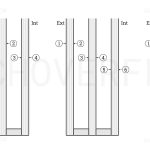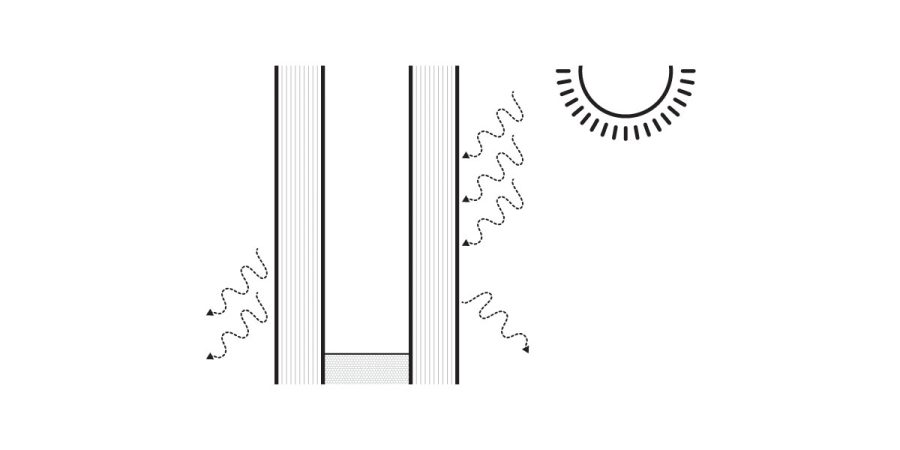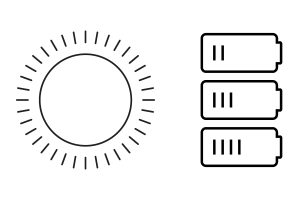Quicklinks:
- ArchOverFlow Glass & Glazing Types
- ArchOverFlow Glass & Glazing Assemblies
- US Energy Government – Windows Doors and Skylights
Introduction
Sunlight and views are vital to psychological well being. Many studies have shown evidence that people generally do better in sunlight and with views across nature; this includes doing better on tests, working more efficiently, and recovering from health issues faster. While there are many benefits to glazing in a building, the glass can be a major source of heat loss and heat gain in a building.
Energy Measurements & Variables
Many different measurement values have been developed in order to gauge the efficiency of different glazing systems. One of the hardest pieces to navigate between glazing efficiency is balancing the efficiency with other more aesthetic aspects like clarity and color.
U-Value
- U-Value is also known as the U-Factor.
U-Value measures the rate of heat transfer and tells you how well a building element insulates. U-Value is commonly thought of similarly to R-Values, because the values are the reciprocal of each other. Meaning that higher R-Values mean better insulation performance, and a lower U-Value means better resistance to heat loss. While U-Values can be used for any building material, they are commonly only used for glazing assemblies and therefore the section is located on this page. R-Values measure insulation are used for wall assemblies and other materials.
- Measured in W/(m²K)
- U-factor values generally range from 0.25 to 1.25
- 1.1 to 1.2 = About a single pane of regular glass
- The lower the U-factor, the better the material insulates. This indicates slow heat loss and slow heat gain
- Low U-factors are most important in heating dominated climates (cool zones)
- It is possible for a windows performance and U-values to be different for summer and winter. Many suppliers will provide both values.
U-Value vs R-Value
While the U-factor is used to express the insulation value of windows, R-value is used for insulation in most other parts of the building envelope (walls, floors, roofs). While they are related, different assumptions and test criteria are used in calculating the two values so they cannot be ‘exactly’ converted. However, to roughly compare R-value and U-factor, divide 1 by the U-factor number, E.g.: a 0.25 U-factor equals a 1/0.25 = 4 R-value.
Solar Heat Gain Coefficient (SHGC)
The SHGC of a glass measures the amount of solar radiation that is transmitted through the entire glazing assembly. This value is expressed as a fraction of the total amount that strikes it.
Basically this measures the fraction of solar energy transmitted and tells you how well the product blocks the heat caused by sunlight. This does not refer to light radiance, but only heat gain.
- SHGC is measured on a scale of 0 to 1; values typically range from 0.25 to 0.80.
- Generally .25 or lower would be desired for a lower air conditioning bill
- Generally .35 or more would be desired in climates or for clients that want more heat gain.
- The lower the SHGC, the less solar heat the window transmits. (heat gain through radiation). This means it would block more of the heat during the summer, and would be better for air conditioning loads.
- The higher the SHGC, the more solar heat gain the window transmits. This means it would allow more heat in during the winter, effectively reducing your heating bill.
- A value of 1.0 would indicate a window assembly that lets all solar radiation pass through, and a value of zero would indicate a window assembly that lets none pass through it.
- The SHGC calculation includes the effects of the frame, glass spacer, and other parts of the window assembly.
Relative Solar Heat Gain (RSHG):
The ratio of solar heat gain through a window, corrected for external shading, to the incident solar radiation.
This heat gain includes directly transmitted solar heat and heat absorbed from solar radiation, which are conducted into the room.

Glass Surface Counting
Glass surfaces are identified by counting from the exterior face of glass. Every individual pane of glass will have two surfaces, and therefore 2 numbers. This means when counting up window assemblies, there will be an even number for glass surfaces. This is true even when the glass is laminated such as for safety applications.
When discussing with window suppliers, they will call out or show which surface number the Low-E coating, tinting, and other treatments will be applied to.
Misc Definitions
Visible Transmittance (VT)
VT measures the amount of light the window lets through.
- VT is measured on a scale of 0 to 1; values generally range from 0.20 to 0.80.
- The higher the VT, the more visible light you see.
Super Windows:
Triple glazing assembly with 2 (two) Low-e coatings. These windows can gain more solar heat gain than they lose during a 24 hour period in winter.






Leave a Reply
You must be logged in to post a comment.